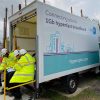Wales Mandates Gigabit Ready Broadband for New Social Housing

The Welsh Government (WG) has just published an updated version of their quality requirements for any new affordable homes that are funded by the WG itself (e.g. social housing), which among other things will require that they must now be made “ready” for gigabit-capable broadband ISP connections.
The ‘Welsh Development Quality Requirements‘ (WDQR2021) document, which was first published in 2006, generally sets out the standards for any new affordable homes funded by the WG. The latest 2021 update of this document has been revised to make several changes, such as by promoting low carbon designs, as well as moving away from fossil fuels for domestic heating and hot water systems.
Beyond low carbon targets, the updated requirements also stipulate new properties to be “gigabit ready”, which means that either Fibre-to-the-Premises (FTTP) broadband or “gigabit wireless” technology is available, alongside a “choice of internet service providers” (i.e. the restrictive approach of Persimmon Homes might struggle with this one).
Advertisement
Where such connectivity isn’t in place, the document states that infrastructure to enable future installation without disruption must still be provided (e.g. supporting cable ducts), although strictly speaking the original rules – as adopted through EU law some years ago – effectively already required this.
The new standard will come into force from 1st October 2021.
WG Statement
“These changes, along with a recognition of the need to consider space for home working, are in direct response to the pandemic, which saw much of the country needing to learn and work from home.
This is not only intended to boost wellbeing and keep communities together, but to respond to the changing needs of residents, for example ample floor space to ensure adaptations for older and disabled people can be facilitated.
Modern methods of construction, such as the use of timber and factory-built homes are also championed in the new guidelines.”
We should point out that the UK Government are currently still in the process of preparing changes that will make it mandatory for property developers to ensure that almost every new home is built with support for “gigabit-speed” (1Gbps) broadband ISP connections “fit for the future” (here), although last year’s COVID-19 lockdown did slow progress on their proposed changes to the Building Regulations (2010).
However, building regulations are a devolved matter, thus the proposed amendments to the Building Regulations 2010 will only apply to England. However, the government did say that they intended to “work closely with the Devolved Administrations” (i.e. Scotland, Wales and N.Ireland) to help them implement this in a consistent way across the UK.
Advertisement
We note that the Government recently (May 2021) began work to reform Part R of the Building Regulations in England by conducting a review of the rules (here) in order to support the aforementioned ambition. All of this will of course complement their £5bn Project Gigabit programme, which seeks to extend gigabit connectivity to reach at least 85% of UK premises by the end of 2025 (i.e. focusing on the final 20% of hardest to reach rural and semi-rural areas).
Mark is a professional technology writer, IT consultant and computer engineer from Dorset (England), he also founded ISPreview in 1999 and enjoys analysing the latest telecoms and broadband developments. Find me on X (Twitter), Mastodon, Facebook, BlueSky, Threads.net and Linkedin.
« ISP Pure Broadband Target Double UK Growth Over Next 3 Years
Broadband ISP Zen Internet Aim to Double UK Revenue in 5 Yrs »























































There are a number of problems I can foresee here if a property builder builds new properties with access to some network ie by using underground duct say those costs will be born by the property buyers and I would imagine shared collectively but surely the the problem comes to a head when the site connect day comes and will ultimately depend on the then currently available technology yes you have a route available to the property you can put in fibre to the property but what do you do with the other end imagine the builder has bought a field built 20 houses and the nearest street cabinet is 2 miles away and has only has FTTC ok because the property has a duct it can be upgraded in future but by who BT Virgin Kcom just for example and this then raises the question of infrastructure maintenance who is responsible for damage repairs with all different service providers using the same access duct?
Great questions and most are addressed by builders in 2 ways, either the management company for the development continues to maintain the ducts or the ducts are taken over by a provider, eg VXFiber who then put the fibre in and deliver multiple ISPs on their wholesale network. OR, VM etc could come in and do the same.
@Regorimabitbackward
A little bit of punctuation would go a long way to making your post readable.
Most suppliers are happy to take over ducts with Virgin (and probably Openreach) supplying all building materials free of charge. Putting the ducts in makes it ready and I doubt Openreach would install FTTC on a housing estate today.
“choice of internet service providers” would be hard to enforce for all new homes as a lot current providers either are a combined network/ISP or have exclusive ISP arrangements in place.
Even if it were building developers create multiple companies for each development on the fly to minimise their liabilities and therefore if they wanted to they could easily set up multiple ISPs just as easily.